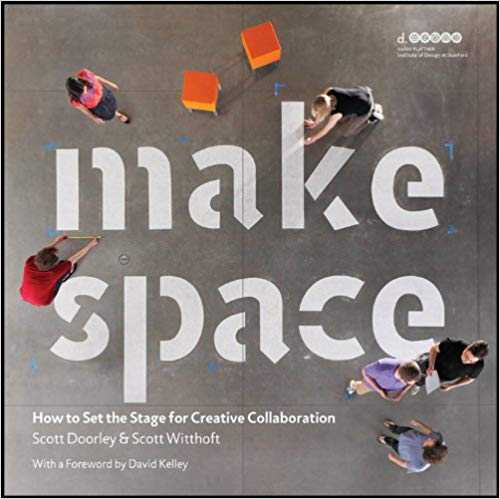Make Space: How to Set the Stage for Creative Collaboration
by: Scott Doorley, Scott Witthoft
We're smart apes. Deal with it. Design ways to keep our bodies moving.
Less adornment = less styling
Less styling = more timeless.
…
Places and Properties address the divisions in a space and the features within them; Actions and Attitudes address who is in the space and what they do.
Properties are the specific aspects of people or space that can be enhanced or altered to impact behavior.
(eg. personal posture can be drastically altered with seating modifications. Ambience attributes, such as lighting, can be used to evelvate mood.)
Actions are behaviors and tasks.(eg. designers tend to visually saturate work spaces with project inspiration and artifacts.)
Attitudes are cultural values and habits. (eg. “Bias toward Action” is a core value at d.school)
The home base is a physical or digital space where individuals or teams anchor their work and identity. From an emotional perspective, it is the creative center of gravity from which people advance and retreat
- A place to access unique resources and tools.
- A place for things: persistent and accessible storage for work in progress.
- A place to showcase contributions: to display and share insights, work, and practice.
- A place for community to flourish: to share ideas, aspirations, and emotions and to make connections.
We've noticed that the more comfortable people are in their seats, the less comfortable they seem to be with generation ideas, exchanging leadership roles, or moving on to the next activity.
Saturate
Saturation is a process for inspiration. A saturated space is mindfully curated to display and broadcast information, express emotion, and immerse a team in the environment of a problem.
Synthesize
Patterns, trends, themes, and hidden mysteries… this is the stuff of synthesis. Synthesis is about grabbing data from a pile of assorted facts and details, and rearranging data in various ways to create meaning or a strong direction
Before synthesis, people will walk into a room with a bunch of facts and concepts they 'know'. Following synthesis these people will walk out of a room understanding what their knowledge actually means. In between is a messy task involving unpacking data and ideas and recombining them into new insights. This is a big shift, and a difficult task, but it si the often unacknowledged foundation of innovation.
Focus is the narrowing on a single topic or task. I tis the art of letting go: what you decide not to do is as important as what you are doing. In some instances letting go means abandoning something completely, and in other cases it means setting it aside completely, and in other cases it means setting it aside temporarily.
Flaring is a phase for exploring possibilities and generating options.
Realization is the process of making the ethereal tangible.
Reflection is often seen as a conclusion, but really, it is a highly dynamic transitional activity. Reflection is best approached with an open mind and a learner's bias. Insights culled from mistakes - there are always mistakes - are helpful in preparing for the future, but dissecting what went 'right' is every bit as helpful and informative.
Show, don't tell
Bias toward action
Focus on human values
Be mindful of process
Prototype toward a solution.
Deliberately incorporating a ritual into a routine can transform the mundane into a minor magic moment.
+ A sense of excitement and limitless possibility.
The sense of potential is empowering, yet rarely realistic.
Enjoy this part as it happens, but not so much that you are afraid to let go.
— Overwhelming complexity
you'll discover a seemingly endless pile of emotional and logistical factors simultaneously at play.
Too much thinking here means trouble. When you are in the territory, focus on the doing.
Acknowledge and categorize new issues as they arise, but prioritize.
+ Unifying insights
These are moments of clarity when you feel you've got it all figured out.
- glorius but possibly derailing
— Complete loss of confidence
— The brutal realities of implementation
Almost everything you do will take longer than you think because there is a lot more to consider than is apparent.
Have strength to stand up for the right things and the wisdom to let go of the meaningless bits.
+ Completion
You may experience some post-partum malaise. Don't wallow in it.
Do take time to celebrate your accomplishment and reflect on your process.
Reflection is important to make your next steps more efficiet.
Book References from Make Space: How to Set the Stage for Creative Collaboration
- Thoughtless Acts?: Observations on Intuitive Design by
Notes: SCCL: No - Experiences in Visual Thinking by
Notes: SCCL: No - The Eureka Hunt by
Notes: article - Cosmic View the Universe in Forty Jumps by
Notes: SCCL: No
